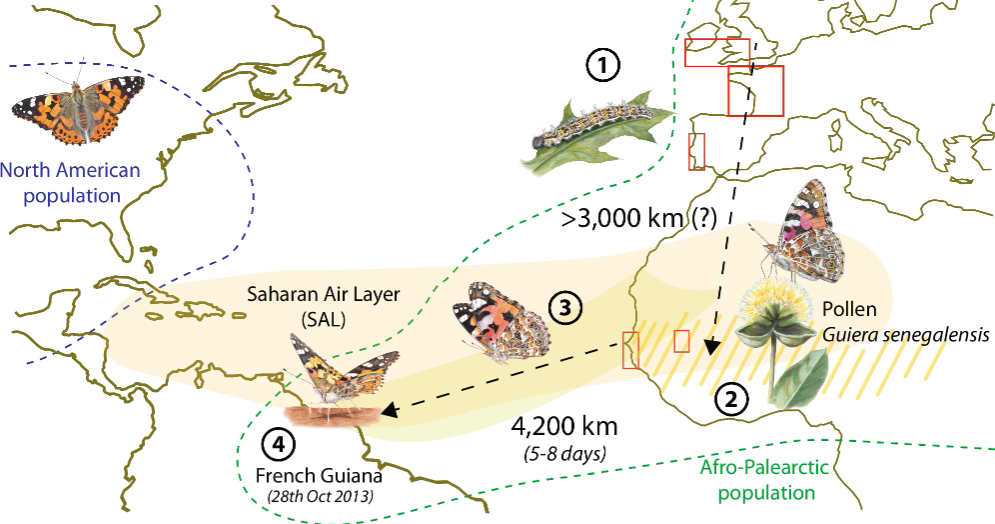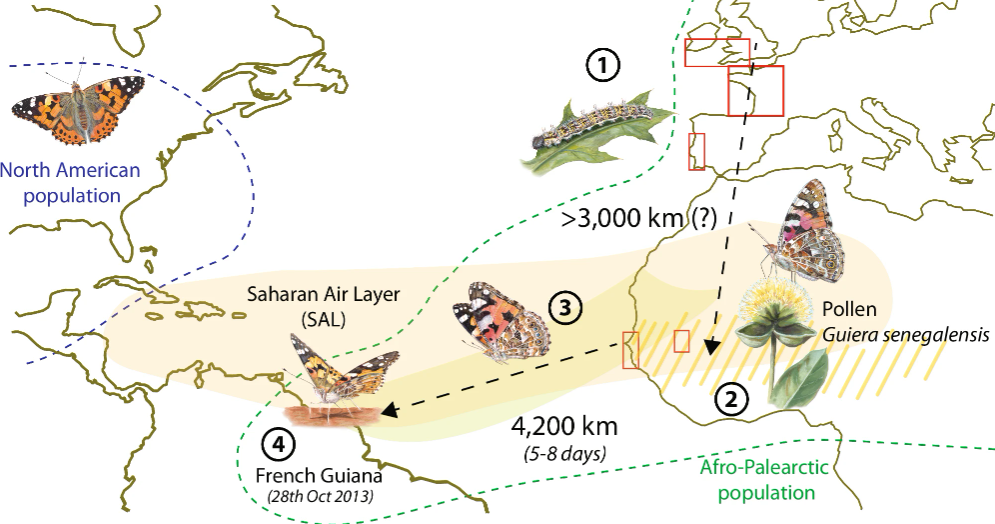An international team led by the Higher Council for Scientific Research (CSIC), an institution affiliated with the Ministry of Science, Innovation and Universities, He documented a trans-oceanic voyage of over 4,200 kilometers undertaken by Thistle Moths (Vanessa Cardoy), Which is a record for the insect. The study, published in the journal Nature Communications, documents A voyage that lasted between five and eight days, made possible by trade winds.
Researchers from the Barcelona Botanical Institute (IBB), A joint center between CSIC and Consorci Museu Cièncy Naturals de Barcelona, as well as the W. Szafer Botanical Institute (Poland), the University of Ottawa (Canada), the Institute of Evolutionary Biology (IBE, CSIC -Universitat Pompeu Fabra) and Harvard University (United States) participating in the study. .
Record flight for a small insect
In October 2013, Gerard Talavera, a researcher from the CSIC Barcelona Institute of Botany, Several Chardon butterflies have been identified on the Atlantic beaches of French Guiana. These sightings were quite unusual, as this species is not found in South America. Where did they come from?
New techniques to solve the puzzle
The multidisciplinary approach made it possible to decipher the path and origin of these butterflies. The first two hypotheses were that it could have originated in North America, where the closest populations were found, in Africa or in Europe. By analyzing wind paths, the researchers observed a sustained trend from West Africa, Opening the possibility of crossing the Atlantic Ocean.

By studying the genetic diversity of butterflies, This required collecting samples from populations from all continents, The researchers determined that the specimens observed in South America were related to populations in Europe and Africa, ruling out the possibility that they originated in North America. The researchers also analyzed the DNA of the pollen that the butterflies carry on their bodies, and identified two species of plants that are only found in tropical Africa. Indicating that butterflies visit the flowers of this area.
finally, The team analyzed stable isotopes of hydrogen and strontium from the butterfly wings. The wings retain isotopic signals specific to where they were reared during the larval stage, allowing their birth origin to be inferred. Thanks to this data, They decided that their origin was most likely in Western Europe. Such as France, Ireland, the United Kingdom and Portugal.
“The thistle moth arrived in South America from West Africa, Flying at least 4,200 kilometres over the Atlantic Ocean. But their journey could have been even longer, starting in Europe and crossing three continents, representing a migration of 7,000 kilometres or more. “This is an extraordinary achievement for such a small insect,” explains Clement Bataille, a professor at the University of Ottawa in Canada and co-author of the article.
“We tend to think of butterflies as symbols of fragility and beauty, but science shows us that they can achieve amazing feats. “There is still a lot to discover about their capabilities,” says Roger Villa. Researcher at the Institute of Evolutionary Biology (CSIC-Universität Pompeu Fabra) and co-author of the study.
With the help of wind
The researchers modeled the energy costs of the trip, and estimated that the non-stop journey across the ocean took between five and eight days. This journey was made possible because it was facilitated by favorable wind currents. “The butterflies were only able to make this flight using a strategy of alternating with minimal effort to avoid falling into the sea, which was facilitated by higher winds and active flight that required more energy. We appreciate that without wind, Butterflies could fly a maximum of 780 kilometers before they used up all their fat and therefore their energy. Eric Toro Delgado, one of the authors of the article, explains.
Researchers highlight the importance of the desert air layer as a potential highway for aerial spread. These wind currents, which prevail throughout the year, transport large quantities of Saharan dust from Africa to the Americas and participate in important biogeochemical cycles. However, the share of the transported biological components, including living organisms, needs to be studied in depth.
Migration in the context of global change
This discovery suggests that there may be natural migration routes that connect continents and facilitate the spread of species much more widely than previously imagined. “This discovery opens up new insights into the ability of insects to disperse long distances, including across seas and oceans,” says Gerard Talavera, the study’s leader. “Throughout history, Migration phenomena have played an important role in determining the distribution of species as we observe them today. He adds.
The research team confirms that with global warming and changing weather conditions, we are likely to witness more disturbances, or even an increase in these phenomena spreading over long distances. Which could have serious consequences for biodiversity and ecosystems around the world.
“It is necessary to strengthen systematic monitoring measures for dispersed insects. “Which can help predict and mitigate potential risks posed by climate change to biodiversity.” Mr. Talavera concludes.
Article reference:
Suchan T, Bataille CB, Reich MS, Toro-Delgado E, Villa R, Pierce NE, Talavera G. (2024). A transoceanic journey of over 4,200 km by the Painted Lady Butterflies.Nature Communications. doi: doi.org/10.1038/s41467-024-49079-2

“Hardcore beer fanatic. Falls down a lot. Professional coffee fan. Music ninja.”







More Stories
Intel has finally dropped DDR4 support with its Arrow Lake 800 series motherboards.
Windows 11 Photos App Is Slow, But Microsoft Has Found a Solution
Major Expansion: Google Translate is now available in 243 languages